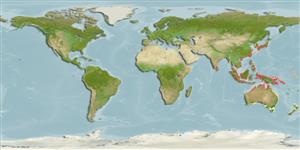Environment: milieu / climate zone / depth range / distribution range
पारिस्थितिकी
समुद्री प्रवाल-भित्ति संयुक्त; गहराई सीमा 5 - 20 m (Ref. 90102). Tropical
Indo-West Pacific: India east to Sagami Bay, Japan and China. A new record was reported from southern Indonesia (Ref. 5978).
आकार / वज़न / Age
Maturity: Lm ? range ? - ? cm
Max length : 14.0 cm TL पुल्लिंग / अलिंग; (Ref. 559)
पृष्ठीय रीढ़ (सम्पूर्ण) : 10; पृष्ठीय सौफट रेज़ (सम्पूर्ण) : 12; गुदा कांटा: 3; ऐनल सौफट रेज़: 6. Distinguished from C. aprinus by the bright yellow coloration when viewed underwater (Ref. 48636).
Occurs on rocky cliffs in deep water (Ref. 9710). Also inhabits muddy substrates in protected bays where wave action has no influence (Ref. 48636). Solitary (Ref 90102).
Life cycle and mating behavior
Maturities | पुनरुत्पत्ति | Spawnings | Egg(s) | Fecundities | लार्वा
Bi-directional sex change has been confirmed for this species (Ref. 103751). Sexual pattern seem to be intermediate between simultaneous and sequential hermaphroditism: individuals, at least under conditions of captivity, have the capacity to change sex in either direction, from functional male to functional female, or vice versa (Ref. 31569).
Masuda, H., K. Amaoka, C. Araga, T. Uyeno and T. Yoshino, 1984. The fishes of the Japanese Archipelago. Vol. 1. Tokai University Press, Tokyo, Japan. 437 p. (text). (Ref. 559)
IUCN Red List Status (Ref. 130435)
Threat to humans
Harmless
Human uses
साधन
Special reports
Download XML
इंटरनेट स्रोत
Estimates based on models
Preferred temperature (Ref.
123201): 21.4 - 29.3, mean 28.7 °C (based on 1745 cells).
Phylogenetic diversity index (Ref.
82804): PD
50 = 0.5039 [Uniqueness, from 0.5 = low to 2.0 = high].
Bayesian length-weight: a=0.01585 (0.00637 - 0.03944), b=3.01 (2.79 - 3.23), in cm total length, based on LWR estimates for this (Sub)family-body shape (Ref.
93245).
Trophic level (Ref.
69278): 4.0 ±0.67 se; based on food items.
Fishing Vulnerability (Ref.
59153): Low vulnerability (10 of 100).
